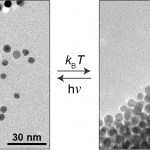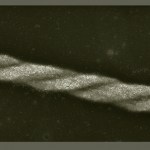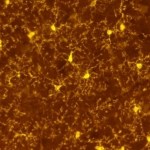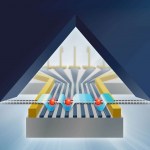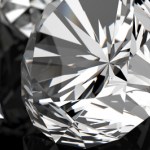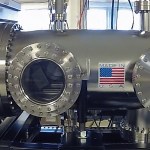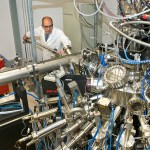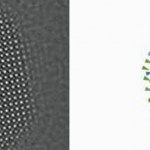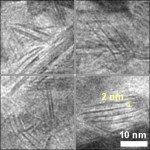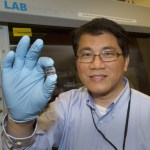nanoscience
One day in the future, we may be treating our ailments with microbiotic combinations designed specifically to correct imbalances in our personal microbiomes. We’ll bring our prescriptions on rewritable paper and pay using shimmery optical chips embedded in our cell phone cases or maybe our jewelry. Or we’ll be waiting in our doctor’s office for a simple test of our microbiogenome to see if a light-based nanoparticle delivery treatment is working, while watching iridescent optical displays that change as we move...
These future scenarios (and many more) are all imaginary, but…
Once again, there are three new pieces online on our website, each wonderful in its own way. But Haiku just didn’t seem to fit this batch. So, with apologies to the scientists, here are three limericks on the newest Institute research. As before, follow the links to get to our website.
(Incidentally, there is some precedent for limerick writing at the Weizmann Institute. The late Prof. Amikam Aharoni, who also wrote some serious stuff on ferromagnetism, was known for his limericks.)
The Quasar
There once was a baby black hole
That went for a short little stroll
It zigged and it zagged…
More science-themed haikus. I seem to keep writing them because we tend to put out three “mini press releases” at a time (a relic of the days when they were printed on two sides of a fold-up page and mailed). So I could pick just one to blog about, or I could try to fit all three into one post (which tends to get muddled when it is on subjects as varied as physics, neurobiology and genetics). Or else I can leave these little breadcrumbs inviting you to follow them back to our website, where the fuller explanation awaits (or, from there, you can follow the links in the releases to get to the…
Of the four new articles online on our website, three happen, purely by accident, to be on physics research. The three are very different, and yet each is an illustration of the ways that basic physics research changes our world – in small and large, practical and enlightening ways. And each is situated at a different intersection between the technological and the theoretical – a technological breakthrough that resulted from a successful attempt to provide proof for a theoretical construct, new inventions based on elementary physical principles of light, and a theory substantiated through a…
Brookhaven Lab physicist John Smedley wrote this post.
People use diamonds to cut concrete, sharpen knives, and jumpstart wedding plans. As a member of Brookhaven’s Instrumentation Division, I’m on a team that found that diamond also fits the bill for new components in cutting-edge tools we are designing for upgrades for the Relativistic Heavy Ion Collider (RHIC), future linear-accelerator light sources, the National Synchrotron Light Source (NSLS), and NSLS-II-- facilities that researchers from around the world are using to understand more about how the natural world works and how we can…
Ever imagined that an Xbox controller could help open a window into the nanoworld of groundbreaking physics? Well, check out the video above.
Brookhaven scientist Ray Conley designed that one-of-a-kind machine to grow (through a technique called sputtering deposition) atomically precise lenses that can focus x-rays to within one billionth of one meter, revealing the internal nanoscale structure of materials such as electric vehicle fuel cells.
When tweaking his recipe for these multilayer Laue lenses (MLL), Conley used to have to manually enter commands into a computer to move a crucial…
See the way those smooth, amorphous blobs rapidly transform into textured honeycombs? Something similar is probably happening right now inside your laptop or smartphone’s battery, providing you with portable power.
But the cherished efficiency and portability of those compact lithium-ion batteries comes with a cost: each cycle of discharge/recharge degrades the material’s essential structure and ultimate longevity - you’ve probably noticed that your older electronics just don’t hold a charge like they used to. Preventing this persistent degradation requires insight into a process that plays…
High-temperature superconductors (HTS), capable of storing and transmitting electricity with perfect efficiency, are a theoretical stumbling block. The mechanism underlying HTS behavior is a mystery, and the subject of significant contention and investigation among scientists. This puzzle, unlike headline-making unknowns such as dark energy (admittedly awesome and worth losing sleep over), could revolutionize our entire energy infrastructure. But before HTS materials can flood the electricity market, they need to work their magic closer to room temperature (high-temperature is a bit…
One of physics’ greatest tricks is polarization. Take magnets, for example, such as those commonly found on refrigerators holding up shopping lists and Christmas cards. These have the familiar north/south polarization that we can experience as attraction and repulsion. That magnetic orientation persists all the way down to the individual molecules, which actually align to cause the larger-scale behavior.
This polar phenomenon is caused by ferromagnetism, a defining quality of some particles that gives them an intrinsic polarity – what scientists call a dipole moment. And remarkably, that…
With nanotechnology rapidly advancing, the sci-fi dream of a Star Trek replicator becomes increasingly less fantastic. But such radical technology would, in theory, require the kind of subatomic manipulation that far exceeds current capabilities. Scientists lack both the equipment and the fundamental knowledge of quantum mechanics (the Standard Model, for all its elegance, remains incomplete) to build items from the raw stuff of quarks, gluons, and electrons . . . but what about alchemy?
Even Isaac Newton, credited with the dawn of the Age of Reason, felt the mystical draw of alchemy,…
Building 3D images gets trickier with objects bilions of times smaller. (courtesy Electric-Eye on Flickr)
Let's start with a number, by chance a palindrome: 1441. Imagine taking that many photographs of a single object, a soccer ball, say - obsessively capturing it from every angle to expose all the details. Those 1441 images provide all the evidence needed to illustrate and understand the three dimensional structure of that soccer ball. Each shot reveals another curve of the sphere, another line in the checkered pattern, another scuff or scratch along the surface.
An adept programmer or…
The following guest post was written by Wei-Qiang Han, a materials scientist working at Brookhaven Lab's Center for Functional Nanomaterials.
Wei-Qiang Han
With gasoline prices still hovering near $4 per gallon, scientists at Brookhaven Lab's Center for Functional Nanomaterials (CFN) are helping to develop electric vehicles capable of driving hundreds of miles on a single charge. A new compound of five tin atoms and one iron atom (FeSn5) created at the CFN is another development along the road to higher capacity lithium-ion batteries for those vehicles of the future.
Compared to other…
Thanks to the smart nano detectives out there who took a stab at solving yesterday's picture puzzle.
Mystery image #1, aka the "Nano Vortex," shows the different magnetization directions of an arrangement of nickel and nickel oxide. Captured by Center for Functional Nanomaterials (CFN) scientist Yimei Zhu, this photo reveals the local distribution of electromagnetic potential. The ability to directly observe electromagnetic properties at the nanoscale may help scientists engineer new materials that rely on magnetic spin - rather than just electric charge - to control electric current. Such "…
It's time for a little fun. Well, that is, if you consider marveling at modern-art-esque images of extremely small (i.e. on the order of billionths of a meter) materials fun. I do, so I'll assume I'm not alone here.
Take a gander at these two nano images produced at Brookhaven. What are they? Why don't you tell me? Post your best guesses below. The winner gets 10 BNL Nerd Points.* I'll post the answers tomorrow.
Mystery nanomaterial #1
Mystery nanomaterial #2
*Obligatory small print: No cash value. Cannot be used in lieu of a thesis defense, as payment for your graduate student, or as a…
A little more than one year ago, on the day of its groundbreaking ceremony, the National Synchrotron Light Source II (NSLS-II) construction site was nothing more than a whole lot of dirt. Today, it's...well, take a look for yourself.
The NSLS-II construction site on the day of the groundbreaking ceremony, June 15, 2009, and...
...exactly one year later
Construction is quickly progressing on the $912 million facility, which will be the world's most brilliant light source. Eh, what's a "light source?" Basically, it's a particle accelerator that, in a controlled manner, sheds light of…
Where can scientists collide gold ions at close to the speed of light; take photos of some of the smallest materials known to humans; decipher the structure of proteins vital to everyday life; illuminate the brains of drug and food addicts; and test materials developed for fuel cells and other clean energy technologies - all on one campus?
These things happen every day at Brookhaven National Laboratory, a (very) multidisciplinary, government-funded institution located on Long Island, about 60 miles east of New York City.
Every year, more than 5,000 researchers from around the world join the…
